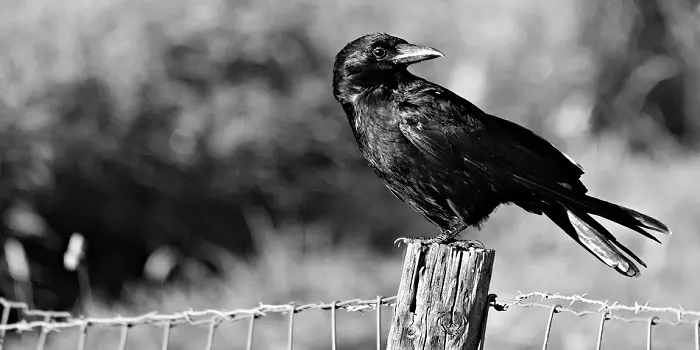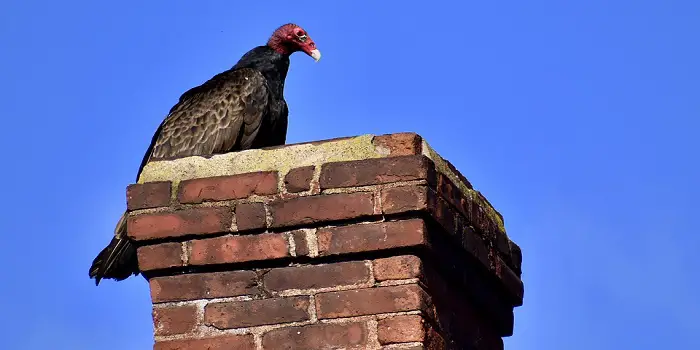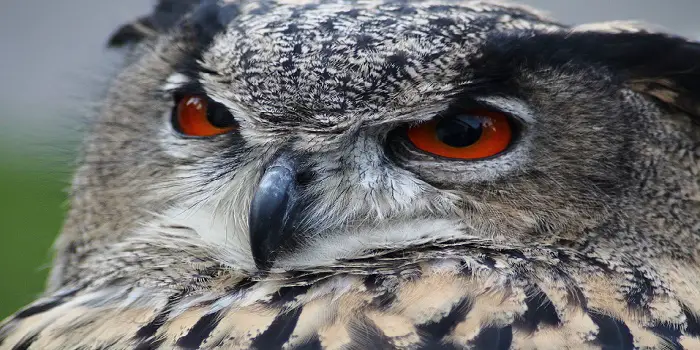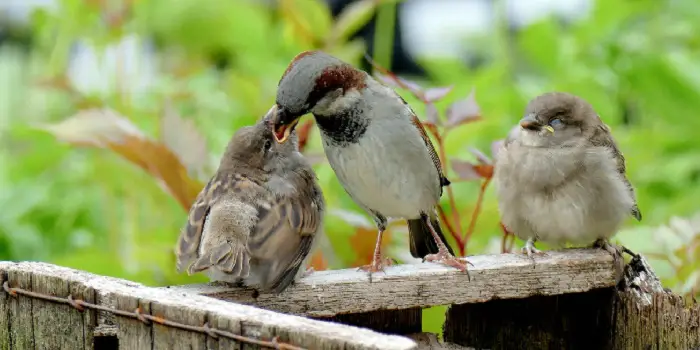
For homeowners and especially those who own commercial properties, spring is a time when you should be on the lookout for the house sparrow.
These birds will often nest in man-made structures like porch awnings because of the safe spaces they offer and nearby locations for food sources.
You’ll often also find house sparrows in small gaps in the framework of buildings, overhangs, and even vents for dryers.
Although relatively small, a sparrow can create big problems due to its droppings that may carry harmful pathogens.
Plus, bugs are attracted to the nests of sparrows, and the nests themselves can be a fire hazard.
For homeowners, the sparrows are a bad enough nuisance, but for owners of commercial properties, the danger can be worse depending on the type of products or services that are being conducted.
So, keeping sparrows out and getting rid of their nests is an important task you shouldn’t ignore.
What are the Most Common Types of Sparrow?
The first step to stopping English house sparrows from building a nest is to identify the type of sparrows that are nesting.
And since there are different types of sparrows in the world, these may be difficult to identify from one another.
The three most common ones include:
1- House sparrow
This family of sparrows is found in all types of climates and habitats, and they tend to live in close contact with humans.
These sparrows stand in close connection to Italian sparrows and Spanish sparrows of the Mediterranean areas.
House sparrows are commonly found in Eastern Asia, and their cousins are known as tree sparrows.
The North American native sparrows don’t belong to the House sparrow’s species.
They have a round and long tail which is pushed up and down during flight.
They don’t live in deserts or forests and are usually found almost everywhere across the globe.
The female house sparrows are grey and faint brown, while the male ones are vibrant brown with white and black marks.
They generally like to feed on grain, wheat, and insects.
And are food for predators like cats, owls, and some mammals. Some people often keep them as a pet.
2- Chipping sparrow
This species is the tamed one and is mostly seen in North America.
They are beautiful and available in different colors.
Summer chirping sparrows are black colored with a vibrant rust crown, while the winter chirping sparrow is brown in color with a darker shade on the crown.
These birds love to sing loud songs in spring.
They are somewhat the same as Field sparrows, but you can differentiate them by the grey rump during their flight.
They have nests in a tree or shrub transparently so that light can pass through them. They are known to eat all types of insects.
3- White-throated sparrow
This kind features a unique appearance with a white throat mark and yellowish lore. The variations comprise white-striped and tan-striped shades.
Those with white stripes feature a black crown with centralized white stripes, while those with tan-striped have a brownish crown with centralized tan stripes.
They usually pair with different shades of morphology to breed.
During the breeding phase, the white stripe birds get more aggressive in comparison to the tan stripes.
They are known for their beautiful chirps, especially during winters.
You can find them in forest areas, woods, and greenery.
Other than the above, there are also Spanish sparrows, Sindh sparrows, Russet sparrows, Eurasian tree sparrows, and a few more.
But these are less common and are found in some specific regions only.
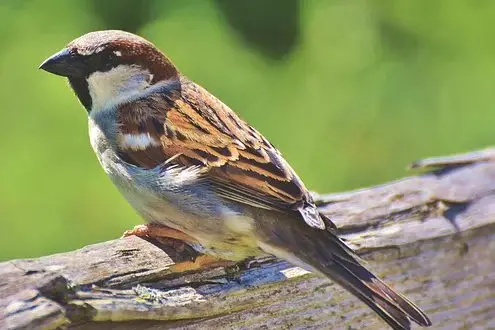
Tips to Keep Sparrows from Nesting on Your Porch
There are two ways to approach the prevention and removal of sparrows from your building which consist of inside and outside protection.
What follows are a few tips that can help, although it should be noted that the bird management firm may also provide additional advice.
1- Block Nesting Areas
Identify the places where sparrows may nest and block them by using hardware cloth, netting, or sheet metal.
If at height, you can reach the nest using a ladder, a step stool, or a long pole at home.
Ensure you cover the areas properly so the sparrows do not have the room to create a nest.
If you plan to destroy or remove the sparrow nest that is already present, remember that it can have sparrow droppings filled with harmful bacteria and parasites.
So, it’s good to wear a mask and gloves.
2- Destroy Sparrow Eggs
Sparrows usually lay 4 to 5 eggs at a time. These will hatch in around 10 to 14 days.
The eggs of the bird, nesting safely on your porch, if destroyed correctly, can help to fend off sparrows very effectively.
You can either do this by obliterating the eggs or in-fertilizing the sparrows’ eggs (refrigerating them or cooking them).
If you are in-fertilizing the eggs, make sure you do it as soon as they are laid.
When not finding their eggs in place, they will think of the possible danger nearby and stop coming back.

3- Repellents and Irritants
These are products that prevent the sparrows from feeling comfortable when trying to perch or nest in and around your building.
You can use products such as tactile gels, sprays, tapes, and powders which will also keep them from perching comfortably on your building.
You can also use hazing products like owl or coyote decoys, reflective devices, lasers, electric strips, bird spikes, bird coils, ultrasonic noises, and some non-lethal chemical deterrents to keep them at bay.
While using these commercial repellents for sparrows, make sure to apply them near their nests.
4- Trap for Sparrows
You can use sparrow traps or mist nets to trap the birds inside the building. This will allow you to safely remove them once they are caught.
Sparrow traps can be used in box traps, baited cage traps, and a few others. You should buy a trap that is reusable and escape-proof.
The good thing about setting the sparrow traps is that they can catch several birds at once.
Since sparrows tend to be very aggressive feeders, make sure that you use the right bait (like seeds, fruits, and nuts) that can attract them the most.
Once you find that the trap is full of birds, you can relocate the sparrows.
But as they may again come back, many people consider drowning the entire cage and birds by submerging the trap in the water.
5- Fire Empty Shots on Your Property
By this, I don’t mean shooting the sparrows down – you should never try, and I don’t recommend doing that.
Instead, you can just fire some empty shots that emit loud sounds to scare away the sparrows nesting on your property.
You fire using an air gun daily for 2-3 days, at the time when you see the most.
This will not only frighten and make the nesting birds go away but also prevent a knot of sparrows from coming and nesting in your place shortly.
Before you try this activity, make sure to check whether your local ordinances allow such a thing.
Finally, you should have regular sanitation and cleanup services around the building to prevent sparrows from using refuse as food sources.
In addition, cleaning up the dropping and debris will also help keep the sparrows away.

Are House Sparrows Aggressive?
House Sparrows (HOSPS) are smart, intelligent, resourceful, and at the same time, very shy.
While they like to be near humans (to demand food), generally, they will not attack people and would like to stay away from them.
But they can attack your hand if you try to grab them.
Plus, there can be significant damages caused by sparrows if not controlled.
Especially if they tend to make a nest in your house and get in contact, they can be a real threat.
a) Health issues
- Often noticed, they possess bacterial pathogens which can cause E-Coli and Salmonella in humans.
- They are also known carriers of avian pox and avian malaria which can reach out to native birds.
- Some of the sparrows may get infected by external parasites like ticks, fleas, or mites. They may also carry parasites like tapeworm and roundworm.
b) Food damages
- Sparrows are also known to cause damage to your grain fields.
- They may impact your livestock production if they infect their feed.
- They can pose a threat to your crops as they feed on seeds, flowers, and fruits.
c) Droppings and waste
- Their droppings are acidic in nature and can damage your roof.
- Their droppings may damage liquids, chemicals as well as plastic at the time of manufacture.
- The feces of sparrows also pose a threat to your air conditioning units or any other commercial machinery.
- They can enter your attic, garage, or basement through unsealed or broken holes, construct their nests, and damage the place with their waste.
Many times, the nests of the house sparrow may also block your drainage system and can also cause severe damage to the attic, roof, and property.
Can You Completely Get Rid of Sparrows in Your House?
Unfortunately, NO
Removing the sparrows altogether from your porch, barn or backyard is not possible.
If you have a large green lawn or a backyard, you will see the flutter of brown sparrows visiting your place most often.
The thing you can do to avoid the damage is either use some repellents or redirect them to other nearby places (like a bird feeder or a feeding station) where they can feed and go.
Here are a few additional tips you can follow to control house sparrows in your backyard…
1- Offer them a huge amount of food
This may seem to be counter-intuitive, but it works.
Instead of offering them expensive bird food at your backyard feeding station, you can offer them cheap cracked corn in large quantities.
Place the cracked corn far away from your bird feeders where the flocks of local sparrows can redirect when they find your backyard feeding station already full of other birds.
This technique can save on expensive food and the need to refill your bird feeders more often.
2- Offer them the food they don’t like much
Since house sparrows are among the most invasive and adaptable birds, they will eat almost everything.
But still, there are a few food items that they do not enjoy eating.
They will only eat them when other favorite food is unavailable.
So naturally, by trying this method, you can control the number of birds coming to your backyard as they will not love eating that food again and again.
Most probably, they will look for some other place where they can find their favorite food.
Some of the foods that seem to work best for controlling house sparrows are striped sunflower seed, suet, shelled peanuts, nyjer seed, and nectar in the nectar feeders.
Remember not to feed birds with salt, onions, garlic, chocolate, caffeine, avocado, and Xylitol.
These food items can be toxic to birds.
3- Let your dogs and cats roam outside
Dogs, cats, and birds like owls, hawks, etc., are known to be the predators o sparrows.
So, the pet dogs and cats in your home can be well employed for bird proofing your home and yard.
You can allow your cats to patrol over areas at a time when sparrows are most commonly seen.
Possibly with the presence of an imminent threat, birds will stop visiting those areas more often.
4- The Magic Halo: Hanging monofilament wire
This strategy is not common but can prove to be effective many times.
This involves hanging a monofilament wire (typically referred to as The Magic Halo) from a squirrel baffle above your feeders to deter the house sparrows.
5- Euthanizing or killing the sparrows
Since house sparrows can be very aggressive toward bluebirds, they will kill them when trapped in a common nest box.
Euthanizing the sparrows is, therefore, among the favorite techniques for bluebird enthusiasts.
If you want, you can trap and euthanize the sparrows in your yard or use a firearm to shoot them down.
To kill them humanely, you can trim their wings so that predators will get them very easily.
You should only take this step when using a firearm if you are trained to use the gun.
Also, make sure that you check the rules and regulations of gun usage and the legality of hunting sparrows in your area before you shoot them down.
Shooting the sparrows won’t be a problem in most parts of the US, as it is legal because of their threatening nature for many native bird species.
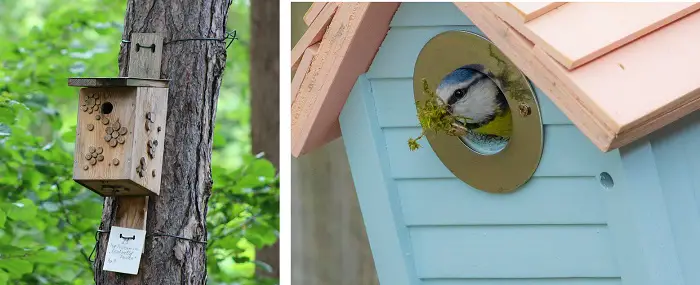
Can Nestbox And Sparrow Spooker Discourage HOSPS From Coming?
Using Nestbox (a bird box to make its nest in) along with a Sparrow Spooker is one great way by which you can discourage House Sparrows from feeding and nesting in your yard.
If you are wondering what is sparrow spooker is – it’s a device that can be DIY made for putting over the roof of a nestbox.
This works (24/7) by deterring House Sparrows (HOSP) from entering a bluebird nestbox.
Keeping the HOSP away helps safeguard the egg’s nestlings or incubating adults from their attack.
If you plan to use these devices to make your house sparrow-proof, ensure you get more information on how to build them, how to use them correctly, and where to place them for success.
Other Related Questions:
Why do sparrows kill their babies?
A mother bird may kill their baby chick if it gets some infection, illness, or deformity.
Mother sparrows may also sometimes eat the remains or push them out from their nest to keep their other babies safe from infection.
What smell do birds hate the most?
Birds like house sparrows hate the smell of the products such as garlic, cayenne pepper, essential oils, and a few others.
If you want, you can use them as a simple home remedy for driving them off your roof or attic.
Do wind chimes keep birds away from my roof?
I had tried this many times (before I started writing at Pro Shield Pest), and all I can say is it works only to offer you temporary results.
Wind chimes (or any other noises for that matter) will only work to keep the birds away for a very short period of time.
As soon as the birds get used to these noises, they will return and keep coming back.
So, if you are seeking ways that can work for the long term, this may not be the option.
What is the difference between a sparrow and a house sparrow?
House sparrows are more opportunist eaters than tree sparrows.
Unlike tree sparrows, they not only feed on seeds but also on any other things they find, like waste food from bins.
HOSP are also a bit larger than tree sparrows and are common in urban areas.
The Conclusion
To keep the sparrows from nesting in the first place, several repellents on the market will dissuade them from building a nest.
Regardless of the type of anti-bird devices, deterrents, repellents, or traps you use, apply them humanely without harming the birds and their babies.
This way, you will also help in protecting other native, protected bird species for good reasons.
Share the post "How to Stop Sparrows from Building Nests in Porch Awnings?"

Welcome to ProShieldPest.com. I am Tina Jones. I have been working as a pest removal professional in Winslow, Arizona lately. At present, I love to spend my time with my family as a retiree.
Here I share all my knowledge and experiences to help people understand better how they can stop pests at their homes without actually killing them. Hopefully, the information you will find here will help in safeguarding your home! You can check more about me here.

